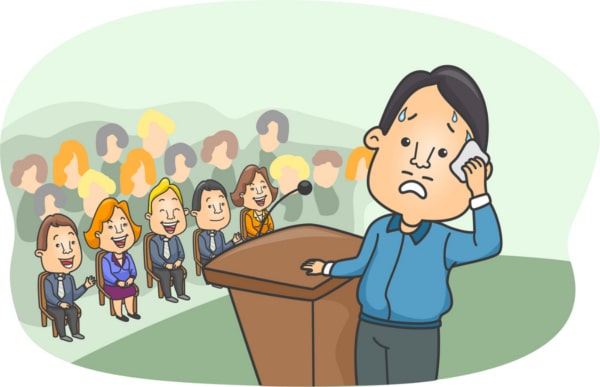This is your moment. They’ll all be looking at you. Will you shine? This research study shows how to greatly increase your chances of public speaking success by decreasing your anxiety.
It’s 2:45 and you’re up in 15 minutes.
Your palms and temples are wet, and you’re hoping your deodorant is doing its job.
 You review your notes for the 411th time and try to remember your mental cues: slow down if they laugh… pause at the end of an idea… look at individual members of the audience… keep breathing…
You review your notes for the 411th time and try to remember your mental cues: slow down if they laugh… pause at the end of an idea… look at individual members of the audience… keep breathing…
But these reminders don’t seem to be slowing down your pulse. You sit back down, waiting, wondering if this will be the time that you pass out or lose your cookies.
The scenario above might seem funny from a reader’s perspective, but for people with public speaking anxiety, it’s actually quite serious.
Most of us in our everyday adult lives have to occasionally get up and speak in front of a group. Even if it’s something informal, like toasting a family member at an event, to somebody with this degree of anxiety, the task can seem as insurmountable and frightening as climbing Mount Kilimanjaro.
Because this particular fear, known as “glossophobia,” affects such a large number of people (10% of adults in the US according to Forbes Magazine, which would be about 32 million), researchers have been working on understanding and treating it for years.
Enter Energy Psychology, an alternative way of understanding and treating a variety of illnesses through restoring flow to the body’s natural life force.
In the early 1980’s, a psychologist named Roger Callahan devised a method of balancing the body’s energy by linking mental health issues to acupressure points. Clinicians would have the patient talk about the issue while they tapped on the corresponding point, which would unblock the flow of energy.
The developer of Emotional Freedom Techniques, Gary Craig, took this one step further by simplifying it so that anyone in the health care field could apply it and teach clients how to do it themselves.
It takes some time for a treatment modality to earn the respect and legitimacy of society and the medical community. Because of the many research studies conducted, however, EFT has been rapidly accepted as an “evidence-based treatment,” particularly by the American Psychological Association for specific phobias.
But is public speaking one of them? Let’s find out…
To Be or Not to Be... A Study
Researchers of this study in Australia recruited 36 volunteer students to fill out a questionnaire about public speaking and fear.
The group was divided into two: the first would receive EFT as a treatment and the other was the wait list/control group. All students were given several questionnaires that are considered reliable measures in research about public speaking anxiety. They were also asked to predict how effective they thought the treatment would be for them on a scale of 0-10.
 The students in the EFT group were asked to give a four-minute speech before the treatment. Then they were shown how to use EFT.
The students in the EFT group were asked to give a four-minute speech before the treatment. Then they were shown how to use EFT.
One interesting aspect of this study was having the students rate their anxiety at three points during the treatment itself: 15 minutes into it, 30 minutes into it, and at the end, at 45 minutes.
After treatment, the students filled out all of the questionnaires again. Finally, they were asked to give another short speech in front of a small group that was video recorded.
Using this recording, the researchers then scored students on observable anxious behaviors, like wetting their lips, swaying, gesturing awkwardly, or pacing.
The control group followed the same protocol, but without treatment. One week later, they came back to the counseling center and also received the Tapping Therapy. They then filled out the questionnaires and gave their video recorded speeches, being evaluated just like the first group.
Toastmasters for Tapping
The overall findings in this study showed that EFT was a highly effective treatment for public speaking anxiety.
Researchers noted the particularly short treatment time and the fact that individuals can even give themselves the treatment without a therapist.

In comparing the questionnaires, researchers found that students who received the EFT treatments felt less anxious in general, and specifically calmer about public speaking post-treatment. There were improvements in anxiety levels, statistically significant ones, on all measurement tools they used.
The anxiety measurements taken at each 15-minute interval during the treatment process showed a steady decline of anxiety throughout. Interestingly, there was a big drop in just the first 15 minutes of doing the tapping.
Applause!
Given how easy it is to teach and learn, and how quickly the treatment begins to work, Tapping is a fabulous tool that could save millions of people from the suffering they experience every time they are required to speak in front of a group of people.
Even when I have to take the stage for a talk or conference presentation, I still tap beforehand because it just simply helps to calm the nerves and provides me with better focus.
If you’d like to try Tapping for your public speaking anxiety, we’ve got a free Tapping Meditation to help you.
Go ahead and give it a try the next time you have to get up to speak in front of others. Your voice and your words could be just what someone else needs to hear.
Until next time…
Keep Tapping!
Nick Ortner
Tell me about a time where you had to speak publicly. How did it go? Do you think Tapping could have helped?
Tapping Research Shown to Ease Your Public Speaking Fears was originally published on: The Tapping Solution
No comments:
Post a Comment